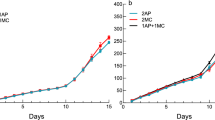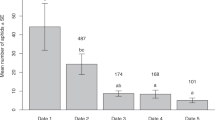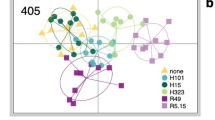Abstract
THE importance of tactile contacts between aphids, or the effet de groupe as first described by Bonnemaison1, has been demonstrated in several species of aphids. Lees2 has reviewed work in this field, and has evaluated the claims of those who have invoked “nutrition” as the important factor in the production of these forms, rather than any crowding factor. He concluded: “Unequivocal evidence that starvation or malnutrition, or specific changes in the quality of the plant sap, can cause isolated aphids to become alatae or alata-producers is still lacking”.
This is a preview of subscription content, access via your institution
Access options
Subscribe to this journal
Receive 51 print issues and online access
$199.00 per year
only $3.90 per issue
Buy this article
- Purchase on Springer Link
- Instant access to full article PDF
Prices may be subject to local taxes which are calculated during checkout
Similar content being viewed by others
References
Bonnemaison, L., Annl. Epiphyt., 2, 1 (1951).
Lees, A. D., Adv. in Insect Physiol., 3, 207 (1965).
Lees, A. D., J. Insect Physiol., 13, 289 (1967).
Johnson, B., Entomol. Exp. and Appl., 9, 213 (1966).
Author information
Authors and Affiliations
Rights and permissions
About this article
Cite this article
SUTHERLAND, O. Role of Host Plant in Production of Winged Forms by a Green Strain of Pea Aphid Acyrthosiphon pisum Harris. Nature 216, 387–388 (1967). https://doi.org/10.1038/216387a0
Received:
Published:
Issue Date:
DOI: https://doi.org/10.1038/216387a0
This article is cited by
-
10.1007/BF00295225
CrossRef Listing of Deleted DOIs (2011)
-
10.1007/BF00295264
CrossRef Listing of Deleted DOIs (2011)
-
10.1007/BF00334955
CrossRef Listing of Deleted DOIs (2011)
-
10.1007/BF00333759
CrossRef Listing of Deleted DOIs (2011)
-
10.1007/BF00297096
CrossRef Listing of Deleted DOIs (2011)
Comments
By submitting a comment you agree to abide by our Terms and Community Guidelines. If you find something abusive or that does not comply with our terms or guidelines please flag it as inappropriate.



